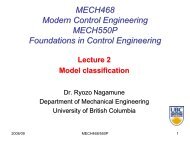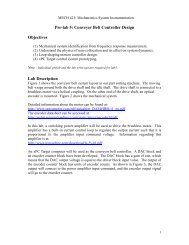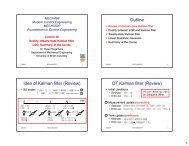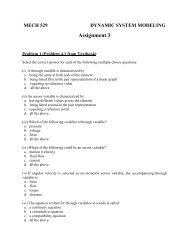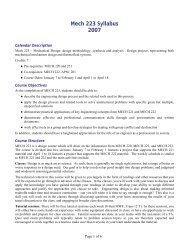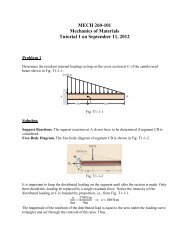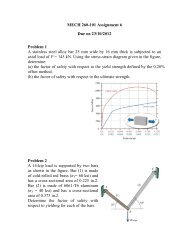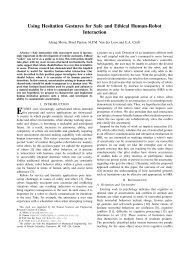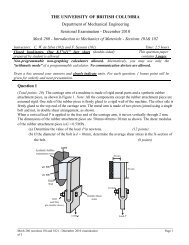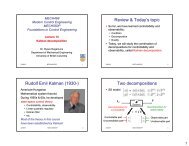solutions - UBC Mechanical Engineering
solutions - UBC Mechanical Engineering
solutions - UBC Mechanical Engineering
Create successful ePaper yourself
Turn your PDF publications into a flip-book with our unique Google optimized e-Paper software.
Foundations in Control <strong>Engineering</strong> (MECH550P-201)<br />
Final exam (50 points). April 17, 3:30pm–6pm<br />
Sketch of <strong>solutions</strong><br />
1. Realize the following transfer functions in both controllable and observable<br />
canonical forms. Select a minimal realization for each transfer function. Explain<br />
the reason why your selected realization is minimal.<br />
(10pt)<br />
[ ]<br />
s<br />
(a) G(s) =<br />
2 + 3s + 3<br />
s 2 + 3s + 2 1 s2 + 3s + 4<br />
. (3-inputs, 1-output)<br />
s 2 + 3s + 2<br />
⎡ [ ] [ ] ⎤<br />
[ ]<br />
03 I A B<br />
3<br />
03<br />
CCF:<br />
= ⎣ −2I<br />
C D [ [ 3 −3I 3 I 3<br />
⎦<br />
] [ ] ] [ ]<br />
1 0 2 0 0 0 1 1 1<br />
OCF:<br />
[ A B<br />
C D<br />
⎡<br />
]<br />
= ⎣<br />
[ ] [ [ ]<br />
0 −2<br />
[ 1 0 2<br />
]<br />
[<br />
1 −3<br />
] [ 0 0 0<br />
]<br />
0 1 1 1 1<br />
]<br />
⎤<br />
⎦<br />
Observable canonical form is minimal, since it is controllable.<br />
⎡<br />
2s + 3<br />
⎤<br />
⎢ s + 1 ⎥<br />
(b) G(s) = ⎣ ⎦ . (1-input, 2-outputs)<br />
s + 3<br />
s + 2<br />
⎡<br />
] ⎤<br />
[ ] A B<br />
CCF:<br />
=<br />
C D<br />
⎢<br />
⎣<br />
[ ] [ 0 1 0<br />
[ [<br />
−2<br />
] [<br />
−3<br />
] ] [<br />
1<br />
]<br />
2 1 2<br />
1 1 1<br />
⎥<br />
⎦<br />
OCF:<br />
[ A B<br />
C D<br />
⎡<br />
]<br />
=<br />
⎢<br />
⎣<br />
[ ]<br />
02 −2I 2<br />
I 2 −3I 2<br />
[<br />
02 I 2<br />
]<br />
⎡<br />
⎢<br />
⎣<br />
[ 2<br />
1<br />
[ 1<br />
1<br />
[ 2<br />
1<br />
]<br />
]<br />
]<br />
⎤<br />
⎥<br />
⎦<br />
⎤<br />
⎥<br />
⎦<br />
Controllable canonical form is minimal, since it is observable.<br />
1
2. Consider a system: ⎧<br />
⎪⎨<br />
⎪ ⎩<br />
ẋ(t) =<br />
[ 0 2<br />
1 −1<br />
]<br />
x(t),<br />
y(t) = [ 1 1 ] x(t).<br />
For each of the following specified locations of the observer poles:<br />
• eig(A − LC) = −2, −3.<br />
• eig(A − LC) = −3, −3.<br />
• eig(A − LC) = −1 ± j.<br />
is it possible to design an observer? If the answer is “yes”, design an observer.<br />
For the system given above, what is the condition for given observer pole<br />
locations to be achievable?<br />
(10pt)<br />
By the direct method,<br />
det(λI − (A − LC)) = · · · = (λ + 2)(λ + l 1 + l 2 − 1).<br />
Therefore, for whatever choice of L, the eigenvalue of s = −2 is impossible<br />
to move. Thus, the first observer poles are possible to achieve with L such<br />
that l 1 + l 2 = 4, but other two observer poles are not possible to achieve.<br />
The condition for given observer pole locations to be achievable is that they<br />
include s = −2.<br />
3. Consider a system {<br />
ẋ(t) = αx(t) + u(t),<br />
y(t) = x(t).<br />
(a) For α = −1, design a state feedback with an integrator such that the<br />
closed-loop poles are s = −1, −1.<br />
(10pt)<br />
det(λI−(A aug −B aug<br />
[<br />
K<br />
Ka<br />
]<br />
) = · · · = λ 2 +(K−α)λ−K a = λ 2 +2λ+1<br />
When α = −1, K = 1 and K a = −1.<br />
(b) Suppose that our modeling is inaccurate and that the actual α is not −1.<br />
For the designed controller in (a), what is the range of the parameter<br />
α that results in zero steady-state tracking error for any step reference<br />
input?<br />
(10pt)<br />
For the designed controller parameters K = 1 and K a = −1, α must be<br />
less than one to keep the closed-loop stability.<br />
2
4. Solve the following continuous-time infinite-horizon LQR problem: (10pt)<br />
min<br />
u(·)<br />
∫ ∞<br />
0<br />
subject to<br />
(<br />
x<br />
2<br />
1 (t) + u 2 (t) ) dt,<br />
[<br />
ẋ1 (t)<br />
ẋ 2 (t)<br />
]<br />
=<br />
[ 0 1<br />
0 −1<br />
] [<br />
x1 (t)<br />
x 2 (t)<br />
] [ 0<br />
+<br />
1<br />
]<br />
u(t).<br />
Verify the stability of the closed-loop system.<br />
Algebraic Riccati equation:<br />
[ √ ] 3 1<br />
A T P + P A − P BR −1 B T P + Q = 0 ⇒ P = √ > 0<br />
1 3 − 1<br />
u(t) = −R −1 B T P x(t) = − [ 1<br />
√ 3 − 1 ] x(t)<br />
The closed-loop system is stable since<br />
A cl := A − BR −1 B T P =<br />
[ 0 1<br />
−1 − √ 3<br />
]<br />
3




